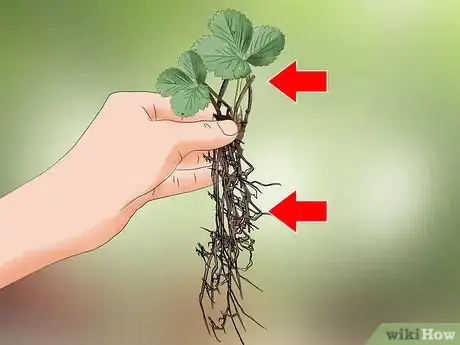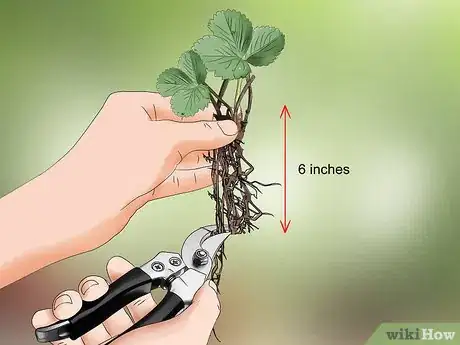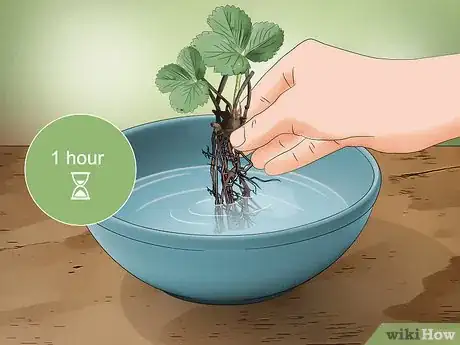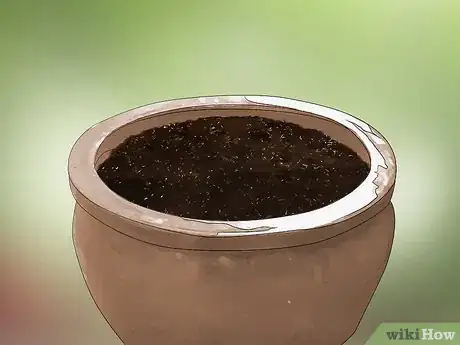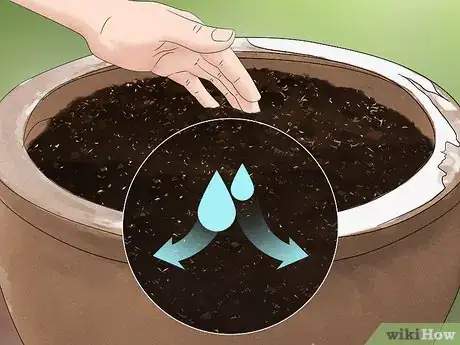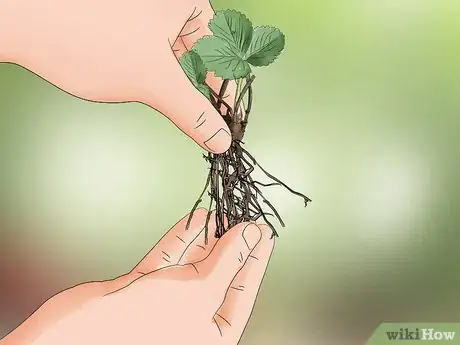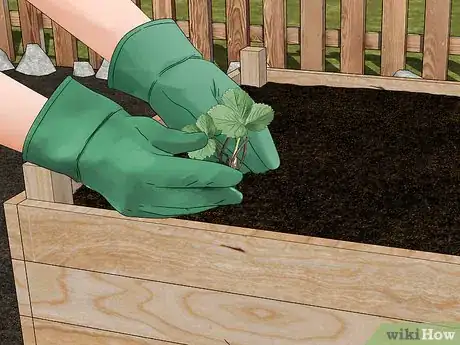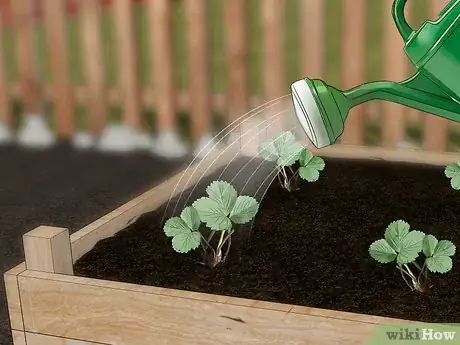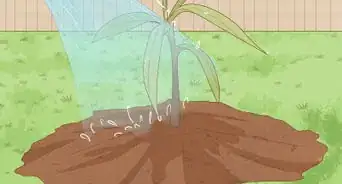X
This article was co-authored by Maggie Moran. Maggie Moran is a Professional Gardener in Pennsylvania.
This article has been viewed 42,666 times.
Buying strawberries from the grocery store can be pricey, but planting bare root strawberries at home is a simple and inexpensive way to grow your own strawberries season after season. By learning how to choose and prepare a bare root strawberry plant, how to prepare the soil, and how to properly plant it in the ground, you will be able to supply yourself with strawberries for years to come.
Steps
Part 1
Part 1 of 3:
Trimming and Soaking the Strawberries
-
1Choose an everbearing variety for fruit all season long. An everbearing strawberry will produce several crops during a season versus the single crop you would get from a June-bearing variety. The Ozark Beauty is the most popular, and it bears large, sweet strawberries.[1]
- Other everbearing varieties are Seascape, Fort Laramie, and Sequoia.
- You can buy bare root strawberries from your local home and garden store or online.
- Bare root strawberries are cheap! You can usually get a bundle of 8-10 plants for $5 or less.
-
2Choose a plant with a healthy crown and long roots. The crown is where the roots meet the stem of the plant. Bare root strawberries are plants that have been removed from the soil while dormant (so in the winter months), so the crown and roots will be brown when you buy them. This does not mean they are dead or unhealthy. Rather, you want to make sure the roots are long (at least 6–8 inches (15–20 cm)) and that the crown is developed.[2]
- A developed crown is a short thickened stem that circles around the leaves and flower clusters. It looks like a wide band that is holding the emerging plant together.[3]
Advertisement -
3Trim roots to about 6–8 inches (15–20 cm) from the crown. Use sharp scissors or garden shears to trim the roots. This will give your plant enough root space to take hold in the soil, and it will keep the roots from getting tangled up with roots from a neighboring plant.[4]
- If the roots aren’t 6–8 inches (15–20 cm), you probably don’t have a well-developed plant and should consider buying new ones.
-
4Soak plants before planting to make sure they are moisturized. Use a large bowl or resealable plastic container, fill it with water, and place your bare root strawberries into the container. Leave them there for 1 hour. This step rehydrates the roots, which will help them be more receptive to growing once you plant them.
- If you won’t be planting for a few days, you can store the plants in the refrigerator for up to a week. Drain most of the water out of the container you were soaking them in and place it in the fridge.
Advertisement
Part 2
Part 2 of 3:
Creating the Right Growing Conditions
-
1Use raised beds to grow a large number of strawberries. Bare root strawberries need to be planted 12–18 inches (30–46 cm) apart, and a raised bed will give you plenty of space for multiple plants.[5]
- If you have an irrigation system (a thin hose with holes punched into it at regular intervals) you can snake this around the raised bed to help you keep your plants evenly watered.
-
2Use pots to keep plants contained in a smaller space. If you don’t have the space for raised beds in your garden, or if you only want to plant 3-4 plants, use a large plant pot for your strawberries. This will keep them contained and allows you to move the pot if needed.[6]
- Make sure to choose a pot that is wide enough to allow for several plants, keeping in mind that they need 12–18 inches (30–46 cm) of space between them.
- Try to purchase a pot that has a draining hole in the bottom for excess water to exit from.
-
3Choose a well-draining, loose soil for your plants. You can add compost or worm compost to the soil to give it extra moisture. If the soil you have is compacted, use a spade to break it up and water it to rehydrate it. Strawberry roots need space to expand, so the looser the soil, the better.[7]
- You can buy new soil from the store if you are starting from scratch, or you can loosen up the old soil and mix it with compost or a new bag from the store. This will also help give your strawberries some much-needed nutrients.
Advertisement
Part 3
Part 3 of 3:
Planting the Strawberries
-
1Dig a small hole for each plant 12–18 inches (30–46 cm) apart. Use a trowel and make a small hole that will fit the roots of your plant. Each plant will only be planted to the crown, so the hole does not need to be very deep. Keeping the plants far enough apart will give them space to expand.[8]
- Strawberry plants need lots of room and sunlight to grow well, so not crowding them when you plant them is the best way to ensure your plants will thrive.
- The best time to plant is in the early spring when the lowest temperature does not go below 25 °F (−4 °C).
-
2Loosen the roots with your hand. Hold the plant by the crown and use your fingers to gently separate the roots so they are spread out and not clumped together in one piece. This will help the roots start to take hold in the new soil.[9]
- Having rehydrated the plant beforehand will help with separating the roots without tearing them.
-
3Place the roots into the soil and fill in the hole with dirt. You want to insert the plant just up to the crown. If the crown is too high (not buried enough) the plant will dry out. If the crown is too low (buried too deeply) the plant will rot.[10]
- Use your spade to tamp down the soil around the plant. Don’t press too hard; just enough so the plant is firmly in the ground and can stand upright on its own.
-
4Water your raised bed or potted plants generously after planting. After you have finished planting all your bare root strawberries, use a watering can or hose to gently water the entire section. This will help encourage the roots to take hold in the soil.[11]
- Throughout the growing season, make sure to keep your plants’ soil moist. You don’t want them to be sitting in water, but you do want to make sure the soil doesn’t dry out or feel crumbly to the touch.
- Use filtered water if possible. Softened or treated water could damage your plants in the long run.
-
5Pick white flowers that bloom the first year to encourage root growth. If you let your plant flower and fruit, the plant’s energy will be going to producing rather than to expanding the roots. Stronger roots means more produce the following summer and increases the chances that your perennial strawberry plants will come back healthy each year.[12]
- Bare root strawberries with healthy, strong roots will often produce fruit for 5 or more years.
- Use your fingers to pluck the small, white blooms from the plant—no need to use gardening shears..”|}}
Advertisement
Expert Q&A
-
QuestionHow long does it take for a strawberry plant to sprout?
 Maggie MoranMaggie Moran is a Professional Gardener in Pennsylvania.
Maggie MoranMaggie Moran is a Professional Gardener in Pennsylvania.
Home & Garden Specialist This depends on the type of strawberry. Certain varieties sprout in 4 to 6 weeks.
This depends on the type of strawberry. Certain varieties sprout in 4 to 6 weeks. -
QuestionHow far apart do you have to plant strawberries?
 Maggie MoranMaggie Moran is a Professional Gardener in Pennsylvania.
Maggie MoranMaggie Moran is a Professional Gardener in Pennsylvania.
Home & Garden Specialist The ideal distance between strawberry plants is 24 inches in rows of about 4 feet apart. This will allow adequate room for the plants to bloom.
The ideal distance between strawberry plants is 24 inches in rows of about 4 feet apart. This will allow adequate room for the plants to bloom. -
QuestionDo strawberries produce fruit in the first year?
 Maggie MoranMaggie Moran is a Professional Gardener in Pennsylvania.
Maggie MoranMaggie Moran is a Professional Gardener in Pennsylvania.
Home & Garden Specialist This depends on the type of strawberry plant. Day-neutral strawberries will offer a good yield in the first year after planting as long as temperatures remain between 35 and 85 degrees F.
This depends on the type of strawberry plant. Day-neutral strawberries will offer a good yield in the first year after planting as long as temperatures remain between 35 and 85 degrees F.
Advertisement
References
- ↑ https://strawberryplants.org/popular-strawberry-varieties/
- ↑ https://www.youtube.com/watch?v=_SiSJPcigjE
- ↑ https://strawberryplants.org/popular-strawberry-varieties/
- ↑ https://www.youtube.com/watch?v=_SiSJPcigjE
- ↑ https://www.youtube.com/watch?v=OonrI68JEVk
- ↑ https://www.youtube.com/watch?v=_SiSJPcigjE
- ↑ https://www.youtube.com/watch?v=_SiSJPcigjE
- ↑ https://www.youtube.com/watch?v=OonrI68JEVk
- ↑ https://www.youtube.com/watch?v=OonrI68JEVk
About This Article
Advertisement

